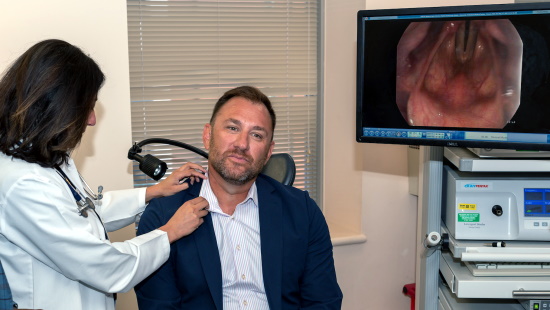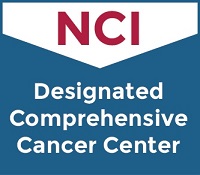Throat Cancer

Treating throat cancer requires an experienced team who can help patients avoid some side effects that could affect the ability to swallow and speak.
The head and neck cancer doctors at the University of Maryland Greenebaum Comprehensive Cancer Center (UMGCCC) look for ways to ease patients' recoveries.
Our team of physicians from a range of specialties create individual treatment plans. Together, they help patients avoid more invasive treatment. We do our best to preserve your voice and swallowing ability. When needed, we work with cosmetic surgeons and speech pathologists to help patients regain their appearance and throat function.
Types of Throat Cancer
Throat cancer is cancer of the pharynx, the scientific name for throat. The throat ends at the branch between the esophagus and windpipe (trachea). Cancer of the digestive tract below this point, but above the stomach, is called esophageal cancer.
Based on its location, throat cancer has different names:
Oropharyngeal Cancer (HPV Throat Cancer)
This increasingly more common type of cancer forms in the middle of the throat, behind the mouth. This includes the walls of the throat, back of the mouth, tonsils, soft palette and back of the tongue.
Experts think that about 7 in 10 cases of oropharyngeal cancer are caused by oral HPV (human papillomavirus), a common sexually transmitted infection.
HPV, or human papillomavirus, is the most common sexually transmitted infection (STI). The CDC estimates that 4 in every 5 sexually active people will have an HPV infection at least once. Most of the time HPV doesn't cause cancer.
Of the more than 200 strains of HPV, about 40 are known to cause cancer in the middle part of the throat (also called oropharyngeal cancer) and/or in the mouth. These are cancers that affect the back of the throat and tongue as well as the tonsils.
In addition to throat cancer and oral cancer, HPV can also cause cancers of the anus, cervix, penis, vagina and vulva.
Larynx Cancer
Laryngeal cancer, one of the more common head and neck cancers, is a malignancy on the larynx, the voice box. Its symptoms symptoms include hoarseness, sore throat and/or a cough, which don't go away. It is linked to tobacco use.
Nasopharyngeal Cancer
This rare type of cancer forms at the top of the throat, behind the nose. It has been linked to the Epstein-Barr virus (EBV)
Hypopharyngeal Cancer
This rare cancer at the bottom of the throat, right above the esophagus (food tube) and behind the voice box (larynx) has been linked to tobacco use.
Throat Cancer Treatment
The UMGCCC head and neck cancer team meets weekly to develop personalized care plans. These plans often include a combination of:
- Radiation therapy uses high-energy radiation to kill cancer cells. Radiation therapy may be used after surgery or in place of it. For advanced cancers, it may be used to shrink the tumor before surgery. Often, oncologists use a highly targeted technique such as intensity-modulated radiation therapy (IMRT). IMRT can decrease radiation on healthy cells and protect sensitive areas of the head. Throat cancers may also be treated with proton therapy, an extremely focused type of radiation therapy that targets the tumor while avoiding healthy tissues.
- Chemotherapy delivers drugs to cancer cells to either kill or stop them from growing. It can be used to target cells that remain after radiation therapy. Sometimes it is used alongside radiation therapy. This combination can be more powerful than if the treatments were given alone at different times.
- Surgery aims to remove the entire cancer and some nearby healthy tissue as a buffer. For cancers that have spread to the lymph nodes, extra tissue may need to be taken out. When possible, our head and neck surgeons use less invasive techniques. They are experienced in robotic surgery in which a surgical robot helps the surgeon operate through the mouth. This approach does not involve incisions on the outside of the neck. It can lessen swallowing-related side effects caused by a throat operation. When an open operation is needed, our surgeons strive to preserve the voice box.
- Targeted therapies, such as monoclonal antibodies, may be given through IV. These treatments single out cancer cells and spare healthy cells.
- Immunotherapies allow the body's immune system to better detect and destroy cancer cells. Often given as pills, immunotherapy may be used to treat more advanced throat cancers.
- Clinical trials can give patients an opportunity to try new, promising treatments years before they are widely available. As a National Cancer Institute-designated Comprehensive Cancer Center, UMGCCC offers a wide array of clinical trials.
Throat Cancer Symptoms:
The two most common symptoms of throat cancer are a persistent sore throat or a lump in the neck. However, other symptoms might include:
- Ear pain or ringing
- Trouble with swallowing, speaking or breathing
- Persistent hoarseness
- Nosebleeds or coughing up blood
Throat Cancer Diagnosis
A throat cancer diagnosis often begins with a physical exam. If a closer look is needed, your doctor may:
- Order imaging tests such as MRI or CT that can show if a cancer tumor is present and if it has spread.
- Order tests that involve a lighted scope (endoscopy, laryngoscopy or nasoscopy) to look inside the throat. These tests can take tissue samples to be examined under a microscope.
- Test for the Epstein-Barr virus or human papillomavirus (HPV). Having these viruses increase your risk for throat cancer.
- For hypopharyngeal cancer, your doctor may order a look inside your esophagus. This test can rule out esophageal cancer.
Make an Appointment
The head and neck cancer team sees patients at a variety of locations in downtown Baltimore near and inside the University of Maryland Greenebaum Comprehensive Cancer Center.
To make an appointment with one of our specialists, please visit Locations and Appointments.



